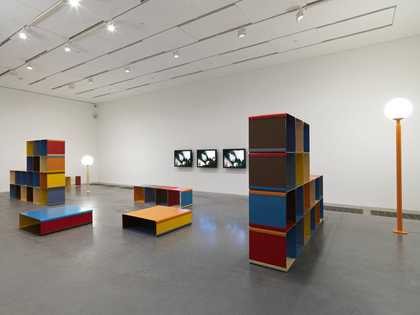The first work for the new sculpture court outside the Clore Gallery at Tate Britain has been commissioned from Liam Gillick. The work will be in two parts, consisting of sculptural elements that are also furniture and a computer animated video piece.
The first part stems from a project in the spring of 2000 when Gillick was guest professor at the CCA in Kitakyushi, Japan. There for a month he created a specifically designed installation in the communal area of the studios, comprising low tables, benches and bookshelves along with Japanese lanterns. Transferring these ideas from this semi-private space to the public space in the new gardens at Tate Britain, Gillick has conceived a social area which people can use to reflect and communicate. This involves the installation of several pieces of sculpture/furniture designed to articulate the space; brightly coloured benches, tables and shelving units, as well as lighting. The work can be situated between architecture, design and sculpture.
The second part of the commission is the presentation of a Japanese computer-animated character called Annlee. Annlee is designed as a commodity, intended for use in either Manga (Japanese adult comics) or in a commercial environment. Her copyright was bought by the French artists Philippe Parreno and Pierre Huyghe, who have used Annlee in works of art. Recently the two artists approached a few friends, including Gillick, offering Annlee to them as an extension of the collaborative sensibility that has developed between them over recent years. Gillick will generate a new image for the character as well as a narrative that touches upon ideas of location, identity and collaboration. The work will also refer to notions of public space and will therefore relate to the sculptural element of the installation.
Liam Gillick was born in Aylesbury, Buckinghamshire, in 1964. He studied at Hertfordshire College of Art, and Goldsmiths College, London. Gillick's work often investigates the relationships of power found within the world of politics and decision-making. Using a combination of text and installations, Gillick provides documentation of the way social and economic realities are shaped and manipulated. Recent group exhibitions include Documenta X, Kassel (1997), David, Frankfurter Kunstverein (1999) and Intelligence: New British Art 2000, Tate Britain (2000) and solo exhibitions include those at the Hamburg Kunstverein (1998) and the Arnolfini, Bristol (2000). Liam Gillick lives and works in London and New York.


